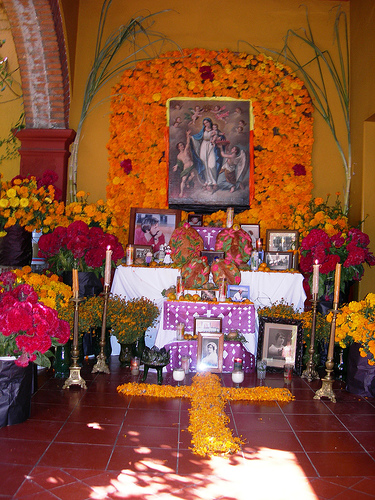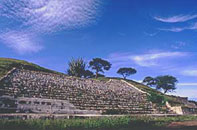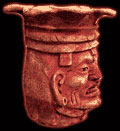| |
| |
|
Dia de los Muertos - Oaxaca, Mexico
|
|
|
|
|
 Dia de los Muertos 2008
Dia de los Muertos (Day of the Dead) is the most time-honored and expressive holiday of Oaxaca. It is an example of the harmonious relationship between Christianity and the prehistoric traditions found in the state of Oaxaca. Although Dia de los Muertos is recognized in all of Mexico, Oaxaca has become known for its traditionally rich celebrations to honor the return of their dead on November 1st and 2nd.
Dia de los Muertos 2008
Dia de los Muertos (Day of the Dead) is the most time-honored and expressive holiday of Oaxaca. It is an example of the harmonious relationship between Christianity and the prehistoric traditions found in the state of Oaxaca. Although Dia de los Muertos is recognized in all of Mexico, Oaxaca has become known for its traditionally rich celebrations to honor the return of their dead on November 1st and 2nd.
In the state capital, Oaxaca City, the festivities of Dia de los Muertos begin a week before the 1 & 2 of November with the commencement of the “Plaza de los Muertos”, which takes place in each market, but principally in the Mercado de Abastos. In each plaza one will find all the necessary items to prepare for the arrival of the dead: the ingredients for traditional mole negro, and pan de yema, traditional Oaxacan chocolate, as well as a grand assortment of flowers which will decorate the sacred altars dedicated to the deceased.
The Oaxacan altars are most commonly built October 30th and October 31st in the homes of the Oaxacan people. The altar is generally set on a table, then it is wrapped with a tablecloth, white sheet or with pricked out tissue paper. Sugarcane is bound to the foot of the table giving it the shape of a triumphal arch. In the morning of October 31st the offerings are placed on the altars; these offerings consist of exquisite dishes that the relatives will come to “taste” the aromas of, among these offerings we find the delicious Oaxacan mole seasoned by the housewives, one day before; the delicious “nicuatole” (corn jelly); pumpkin with black sugar; sugarcane; “tejocotes” (small wild apples); the delicious “pan de muerto” (bread of the dead); the exquisite chocolate ground on a stone blender and a great variety of fruits from the region such as oranges, limes, bananas, jicamas, wild apples, nuts, peanuts, and also nisperos (small tart yellow fruits).
Traditionally, in every Altar of the Dead, the flower of dead – the sweet-smelling “cempasuchil” (marigolds) and ‘’cresta de gallo’’ a deep red flower – should not be forgotten. Another offering that should never be omitted is the oil lamp or the white or yellow wax candles adorned with black tissue paper.
It is an old belief that the dead, after that long pilgrimage from the other life, arrive on earth tired and thirsty, because of this, a gourd or glass filled with water is placed on the altar for them to drink as well as the other food offerings.
It is believed that the last day of October the souls of the children who have passed away come to visit the altars beginning in the late afternoon. Upon their arrival, the children feast upon the food on the altars, as the long trip leaves them famished. November 2nd is reserved for the souls of the adults who have passed away.
|
|
|
|
|
In villages outside the city of Oaxaca, the celebration of Muertos is most commonly known as Todos Santos, or All Saints. This day is often the most celebrated day of the year. The altars, found in the homes of the villagers and in cemeteries are honored by all. It is most commonly located in the cemetery and during the course of Muertos, one will find the graves wonderfully decorated with candles, flowers and food. During this time the living join together to rejoice the return of their ancestors. Visiting cemeteries and homes enables one to enjoy the richness of this celebration as you too will feel the power of the return of the deceased!
In addition to visiting homes and cemeteries, one may experience the cultural richness of this time by witnessing the Comparsas during the afternoon of November 1st, theatrical performances representing the return of the dead, which take place in various outlying villages.
At the Spanish Institute in Oaxaca, we encourage students to take part in the many activities inside and outside the City of Oaxaca. For this reason, we give students the basic information and background for the holiday and take tours to the most important places in the City. We prefer to serve as a bridge for our students to the culture and events so they can explore and understand what they are experiencing. In this way, as many activities take place the same day and often the same time, you may choose which one you feel would be more enjoyable.
You will find that there is much to see and do in the city of Oaxaca and in the outlying villages. For this reason, we offer you the opportunity to partake in a number of different tours to villages, but also encourage you to stay in the city and altars and comparsas around the city. This freedom enables you to discover on your own the wonders this culturally rich time in Oaxaca presents.
|
|
|
|
|
|
 OUR CELEBRATION AT THE SPANISH INSTITUTE
OUR CELEBRATION AT THE SPANISH INSTITUTE
On the grounds of the ISpanish Institute in Oaxaca, , during the course of the week of October 27th to October 31st, we will present to our students a lecture regarding the various cultural events that take place over Muertos and the altars to be seen, as well as their significance.
At the Spanish Institute, we have one of the largest and best altars in the City of Oaxaca. Friday the 31st of October, we invite students to have a comparsa (parade) in the streets near the Institute in which we dance to the music of a band. At the end of the comparsa, students return to visit the altar with us and drink chocolate prepared with water and pan de yema.
It is important to mention that we offer a special mask making workshop during this season, so that students can make masks for the comparsa.
|
|
|
|
| |
|
In addition to the above-mentioned activities, we will offer the additional tours:
|
|
|
|
FRIDAY, OCTOBER 31, 2008
TOUR TO THE CEMETERIES OF XOXOCOTLAN
On this tour, students visit both the old and the new cemeteries of Xoxocotlan to witness a very important Day of the Dead tradition. Graves are decorated with Cempasuchil and Cresta de Gallo flowers, candles, and in many cases, “tapetes de Muertos”, or colorful temporary sand paintings. Family members traditionally remain at the cemetery all night to be with the Muertos, praying, telling stories, eating, singing, etc.
|
|
|
|
|
|
 SATURDAY, NOVEMBER 1, 2008
SATURDAY, NOVEMBER 1, 2008
TOUR TO THE ETLA VALLEY
This excursion to the Etla Valley is planned so that students are able to see the “Comparsas”, or traditional street theatre that takes place in celebration of the Dia de Muertos.
|
|
|
|
|
SUNDAY, NOVEMBER 2, 2008
TOUR TO THE CEMETERY OF SAN FELIPE
This tour takes students to the cemetery of San Felipe del Agua, just north of Oaxaca City where graves are ornately decorated for the Dia de Muertos. This cemetery is interesting because it bears some resemblance to old San Felipe when it was just a small pueblo.
|
|
|
|
|
Tours are highly recommended, but are among the many events taking place inside and outside of the City of Oaxaca. Tours are optional and will cost extra depending on location and length. They are very economical, however, costing US $10.00 to US $26.00.
If you wish to register, please visit our website and fill out on online registration form for Language And Crafts Program for the week of October 27th to 31th, 2008 or you could register as many weeks as you wish to take Spanish Classes in Oaxaca.
|
|
|
|
|
|
|
|
|
|
| |
|
|

